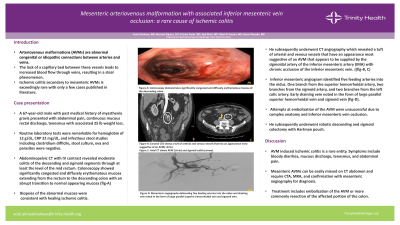Tuesday Poster Session
Category: Colon
P3096 - Mesenteric Arteriovenous Malformation With Associated Inferior Mesenteric Vein Occlusion: A Rare Cause of Ischemic Colitis
Tuesday, October 24, 2023
10:30 AM - 4:00 PM PT
Location: Exhibit Hall

Has Audio

Aciel Shaheen, MD
Trinity Health Ann Arbor
Ypsilanti, MI
Presenting Author(s)
Award: Presidential Poster Award
Aciel Shaheen, MD1, Priyata Dutta, MD1, Michael Zijlstra, DO2, Wael Al-Yaman, MD1, Neil Shah, MD1, Kevin Wenzke, MD1
1Trinity Health Ann Arbor, Ypsilanti, MI; 2Trinity Health St. Joseph Mercy Hospital-Ann Arbor, Ann Arbor, MI
Introduction: Arteriovenous malformations (AVMs) are abnormal congenital or idiopathic connections between arteries and veins. The lack of a capillary bed between these vessels leads to increased blood flow through veins, resulting in a steal phenomenon. Ischemic colitis secondary to mesenteric AVMs is exceedingly rare with only a few cases published in literature.
Case Description/Methods: A 67-year-old male with past medical history of myasthenia gravis presented with abdominal pain, continuous mucous rectal discharge, and tenesmus with associated 25 lb weight loss. Routine laboratory tests were remarkable for hemoglobin of 12 g/dL, CRP 22 mg/dL, and infectious stool studies including clostridium difficile, stool culture, ova and parasites were negative. Abdominopelvic CT with IV contrast revealed moderated colitis of the descending and sigmoid segments through at least the level of the mid rectum. Colonoscopy showed significantly congested and diffusely erythematous mucosa extending from the rectum to the descending colon with an abrupt transition to normal appearing mucosa (fig-A). Biopsies of the abnormal mucosa were consistent with healing ischemic colitis. He subsequently underwent CT angiography which revealed a tuft of arterial and venous vessels that have an appearance most suggestive of an AVM that appears to be supplied by the sigmoidal artery of the inferior mesenteric artery (IMA) with chronic occlusion of the inferior mesenteric vein (fig-B, C). Inferior mesenteric angiogram identified five feeding arteries into the nidus. One branch from the superior hemorrhoidal artery, two branches from the sigmoid artery, and two branches from the left colic artery. Early draining vein noted in the form of large parallel superior hemorrhoidal vein and sigmoid vein. Attempts at embolization of the AVM were unsuccessful due to complex anatomy and inferior mesenteric vein occlusion (fig-D). He subsequently underwent robotic descending and sigmoid colectomy with Hartman pouch.
Discussion: AVM induced ischemic colitis is a rare entity. Symptoms include bloody diarrhea, mucous discharge, tenesmus, and abdominal pain. Mesenteric AVMs can be easily missed on CT abdomen and require CTA, MRA, and confirmation with mesenteric angiography for diagnosis. Treatment includes embolization of the AVM or more commonly resection of the affected portion of the colon.

Disclosures:
Aciel Shaheen, MD1, Priyata Dutta, MD1, Michael Zijlstra, DO2, Wael Al-Yaman, MD1, Neil Shah, MD1, Kevin Wenzke, MD1. P3096 - Mesenteric Arteriovenous Malformation With Associated Inferior Mesenteric Vein Occlusion: A Rare Cause of Ischemic Colitis, ACG 2023 Annual Scientific Meeting Abstracts. Vancouver, BC, Canada: American College of Gastroenterology.
Aciel Shaheen, MD1, Priyata Dutta, MD1, Michael Zijlstra, DO2, Wael Al-Yaman, MD1, Neil Shah, MD1, Kevin Wenzke, MD1
1Trinity Health Ann Arbor, Ypsilanti, MI; 2Trinity Health St. Joseph Mercy Hospital-Ann Arbor, Ann Arbor, MI
Introduction: Arteriovenous malformations (AVMs) are abnormal congenital or idiopathic connections between arteries and veins. The lack of a capillary bed between these vessels leads to increased blood flow through veins, resulting in a steal phenomenon. Ischemic colitis secondary to mesenteric AVMs is exceedingly rare with only a few cases published in literature.
Case Description/Methods: A 67-year-old male with past medical history of myasthenia gravis presented with abdominal pain, continuous mucous rectal discharge, and tenesmus with associated 25 lb weight loss. Routine laboratory tests were remarkable for hemoglobin of 12 g/dL, CRP 22 mg/dL, and infectious stool studies including clostridium difficile, stool culture, ova and parasites were negative. Abdominopelvic CT with IV contrast revealed moderated colitis of the descending and sigmoid segments through at least the level of the mid rectum. Colonoscopy showed significantly congested and diffusely erythematous mucosa extending from the rectum to the descending colon with an abrupt transition to normal appearing mucosa (fig-A). Biopsies of the abnormal mucosa were consistent with healing ischemic colitis. He subsequently underwent CT angiography which revealed a tuft of arterial and venous vessels that have an appearance most suggestive of an AVM that appears to be supplied by the sigmoidal artery of the inferior mesenteric artery (IMA) with chronic occlusion of the inferior mesenteric vein (fig-B, C). Inferior mesenteric angiogram identified five feeding arteries into the nidus. One branch from the superior hemorrhoidal artery, two branches from the sigmoid artery, and two branches from the left colic artery. Early draining vein noted in the form of large parallel superior hemorrhoidal vein and sigmoid vein. Attempts at embolization of the AVM were unsuccessful due to complex anatomy and inferior mesenteric vein occlusion (fig-D). He subsequently underwent robotic descending and sigmoid colectomy with Hartman pouch.
Discussion: AVM induced ischemic colitis is a rare entity. Symptoms include bloody diarrhea, mucous discharge, tenesmus, and abdominal pain. Mesenteric AVMs can be easily missed on CT abdomen and require CTA, MRA, and confirmation with mesenteric angiography for diagnosis. Treatment includes embolization of the AVM or more commonly resection of the affected portion of the colon.

Figure: Figure A: Colonoscopy demonstrates significantly congested and diffusely erythematous mucosa of the descending colon
Figure B: Coronal CTA shows a tuft of arterial and venous vessels that has an appearance most suggestive of an AVM( circle).
Figure C: Axial CT shows AVM (circle) and sigmoid colitis (arrow).
Figure D: Mesenteric angiography delineating five feeding arteries into the nidus and draining vein noted in the form of large parallel superior hemorrhoidal vein and sigmoid vein.
Figure B: Coronal CTA shows a tuft of arterial and venous vessels that has an appearance most suggestive of an AVM( circle).
Figure C: Axial CT shows AVM (circle) and sigmoid colitis (arrow).
Figure D: Mesenteric angiography delineating five feeding arteries into the nidus and draining vein noted in the form of large parallel superior hemorrhoidal vein and sigmoid vein.
Disclosures:
Aciel Shaheen indicated no relevant financial relationships.
Priyata Dutta indicated no relevant financial relationships.
Michael Zijlstra indicated no relevant financial relationships.
Wael Al-Yaman indicated no relevant financial relationships.
Neil Shah indicated no relevant financial relationships.
Kevin Wenzke indicated no relevant financial relationships.
Aciel Shaheen, MD1, Priyata Dutta, MD1, Michael Zijlstra, DO2, Wael Al-Yaman, MD1, Neil Shah, MD1, Kevin Wenzke, MD1. P3096 - Mesenteric Arteriovenous Malformation With Associated Inferior Mesenteric Vein Occlusion: A Rare Cause of Ischemic Colitis, ACG 2023 Annual Scientific Meeting Abstracts. Vancouver, BC, Canada: American College of Gastroenterology.

